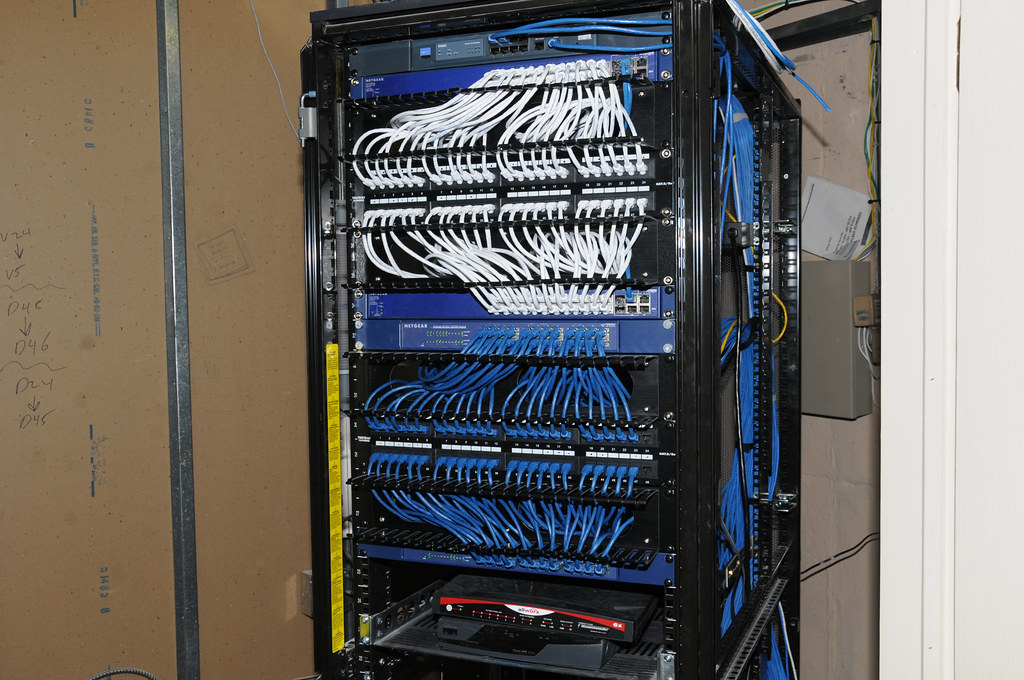Greatone123
[H]ard|Gawd
- Joined
- May 10, 2006
- Messages
- 1,293
Greetings to all [H] Network Gods...
I'm new still to the network scene but I sit here day after day reading posts. Shortly within a month I will be moving to a real home, finally leaving the apartment life, and with that I'll get to wire up the place properly.
My old network was basically all limited to 1 room and looked like this:

my hardware consist of some low end comps running untangle and a little cod 4 server.. nothing special.
my switches consist of 1 1 Gbps trendnet and a 10/100 trendnet... they are starting to lose ports.. and obviously I got them cause they were the cheapest and well I didn't know much at the time.
I'm going to get a 42U rack off craigslist when I spot one...
few questions tho...
Does a switch make that big of a difference in a network?
Does brand of Cat 6 make a difference? can I just go to newegg and get a bunch of Rosewill 50 ft. cables and run those? they are cheap...
Is there any way to have more then 1 comp access to a port? say I wanted to split the workload of say my COD4 servers... 4 server instances.. on 2 boxes? I need the same ports on both? (only 1 wan IP rest are local)
my current idea for a new network would be:

Some stuff I was thinking about getting...
http://www.newegg.com/Product/Product.aspx?Item=N82E16833124129
http://www.newegg.com/Product/Product.aspx?Item=N82E16833122057
2 cables per room on 10/100, 2x to kodiak 2x to workstation 1x betty and 1x printer on 1 Gbps...
2x cables to file... 1 cable to COD4... 1 cable to e-mail whenever I get around to setting that up...
all cables will be run in attic dropped and wall plated...
sooo total cable count is...
10/100
2 x Server room
2 x Kitchen
2 x Garage
2 x living room
2 x master
10/100/1000
2 x Kodiak
2 x Workstation
1 x Betty
1 x Printer
2 x File
1 x COD
1 x E-mail
Color Code:
Blue = 10/100 to other rooms
Green = 10/100/1000 to other rooms
Red = Internet/Gateway/Router Connections on rack
White = Server Connections
Remember this is my first real network attempt... it will be over time... for budget reasons... but I want to take my time and do it right.
I'm new still to the network scene but I sit here day after day reading posts. Shortly within a month I will be moving to a real home, finally leaving the apartment life, and with that I'll get to wire up the place properly.
My old network was basically all limited to 1 room and looked like this:

my hardware consist of some low end comps running untangle and a little cod 4 server.. nothing special.
my switches consist of 1 1 Gbps trendnet and a 10/100 trendnet... they are starting to lose ports.. and obviously I got them cause they were the cheapest and well I didn't know much at the time.
I'm going to get a 42U rack off craigslist when I spot one...
few questions tho...
Does a switch make that big of a difference in a network?
Does brand of Cat 6 make a difference? can I just go to newegg and get a bunch of Rosewill 50 ft. cables and run those? they are cheap...
Is there any way to have more then 1 comp access to a port? say I wanted to split the workload of say my COD4 servers... 4 server instances.. on 2 boxes? I need the same ports on both? (only 1 wan IP rest are local)
my current idea for a new network would be:

Some stuff I was thinking about getting...
http://www.newegg.com/Product/Product.aspx?Item=N82E16833124129
http://www.newegg.com/Product/Product.aspx?Item=N82E16833122057
2 cables per room on 10/100, 2x to kodiak 2x to workstation 1x betty and 1x printer on 1 Gbps...
2x cables to file... 1 cable to COD4... 1 cable to e-mail whenever I get around to setting that up...
all cables will be run in attic dropped and wall plated...
sooo total cable count is...
10/100
2 x Server room
2 x Kitchen
2 x Garage
2 x living room
2 x master
10/100/1000
2 x Kodiak
2 x Workstation
1 x Betty
1 x Printer
2 x File
1 x COD
1 x E-mail
Color Code:
Blue = 10/100 to other rooms
Green = 10/100/1000 to other rooms
Red = Internet/Gateway/Router Connections on rack
White = Server Connections
Remember this is my first real network attempt... it will be over time... for budget reasons... but I want to take my time and do it right.
![[H]ard|Forum](/styles/hardforum/xenforo/logo_dark.png)


